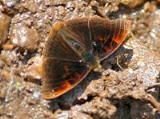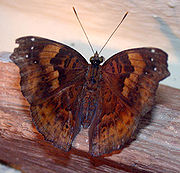
Rohana parisatis
Encyclopedia
The Black Prince, Rohana parisatis, is a species of Nymphalid
butterfly of the family
Nymphalidae
found in Asia
.
Male upperside deep velvety black, with one minute snow-white preapical spot on the fore wing; the cilia of both fore and hind wing alternately black and white. Underside dark purplish brown, shaded at base of wings and along costal margin and apex of fore wing with dark ferruginous; both fore and hind wing with two black spots in the discoidal area, followed by an auriform mark and an irregular median band, crossing both wings, of dark brown, markings outwardly obscurely and interruptedly bordered with lilacine; beyond the discal area both wings are shaded transversely with dark brown, succeeded by a subterminal dark line bordered inwardly with purple; fore wing with the white preapical spot larger; hind wing with a black white-centred minute subtornal spot. Antennae
black ; head, thorax
and abdomen
velvety black, dark brown beneath.
 Female upperside yellowish brown. Fore and hind wings: basal half shaded and marked with brown, with an angulated transverse broad brown median fascia and a postdiscal transverse brown shading; on the hind wing traversed by a series of obscure dark spots; on the hind wing traversed by a series of obscure dark spots; on the fore wing with three, sometimes four, minute subapical white spots; a transverse series of dark lunular markings on both wings, followed by a subterminal dark line. Underside yellowish brown; markings somewhat similar to those in the male, but more clearly defined. Antennae head, thorax and abdomen light brown, yellowish beneath.
Female upperside yellowish brown. Fore and hind wings: basal half shaded and marked with brown, with an angulated transverse broad brown median fascia and a postdiscal transverse brown shading; on the hind wing traversed by a series of obscure dark spots; on the hind wing traversed by a series of obscure dark spots; on the fore wing with three, sometimes four, minute subapical white spots; a transverse series of dark lunular markings on both wings, followed by a subterminal dark line. Underside yellowish brown; markings somewhat similar to those in the male, but more clearly defined. Antennae head, thorax and abdomen light brown, yellowish beneath.
Race camiba, Moore of Southern India and Sri Lanka, is absolutely identical except for the constant minute difference of the fore wing on the upper and under sides ; this has in the male three, in the female five subapical white dots.
Nymphalidae
The Nymphalidae is a family of about 5,000 species of butterflies which are distributed throughout most of the world. These are usually medium sized to large butterflies. Most species have a reduced pair of forelegs and many hold their colourful wings flat when resting. They are also called...
butterfly of the family
Family (biology)
In biological classification, family is* a taxonomic rank. Other well-known ranks are life, domain, kingdom, phylum, class, order, genus, and species, with family fitting between order and genus. As for the other well-known ranks, there is the option of an immediately lower rank, indicated by the...
Nymphalidae
Nymphalidae
The Nymphalidae is a family of about 5,000 species of butterflies which are distributed throughout most of the world. These are usually medium sized to large butterflies. Most species have a reduced pair of forelegs and many hold their colourful wings flat when resting. They are also called...
found in Asia
Asia
Asia is the world's largest and most populous continent, located primarily in the eastern and northern hemispheres. It covers 8.7% of the Earth's total surface area and with approximately 3.879 billion people, it hosts 60% of the world's current human population...
.
Description
- See glossaryGlossary of Lepidopteran termsThis glossary describes the terms used in the formal descriptions of insect species, jargon used mostly by professionals or entomologist....
for terms used
Male upperside deep velvety black, with one minute snow-white preapical spot on the fore wing; the cilia of both fore and hind wing alternately black and white. Underside dark purplish brown, shaded at base of wings and along costal margin and apex of fore wing with dark ferruginous; both fore and hind wing with two black spots in the discoidal area, followed by an auriform mark and an irregular median band, crossing both wings, of dark brown, markings outwardly obscurely and interruptedly bordered with lilacine; beyond the discal area both wings are shaded transversely with dark brown, succeeded by a subterminal dark line bordered inwardly with purple; fore wing with the white preapical spot larger; hind wing with a black white-centred minute subtornal spot. Antennae
Antenna (biology)
Antennae in biology have historically been paired appendages used for sensing in arthropods. More recently, the term has also been applied to cilium structures present in most cell types of eukaryotes....
black ; head, thorax
Thorax
The thorax is a division of an animal's body that lies between the head and the abdomen.-In tetrapods:...
and abdomen
Abdomen
In vertebrates such as mammals the abdomen constitutes the part of the body between the thorax and pelvis. The region enclosed by the abdomen is termed the abdominal cavity...
velvety black, dark brown beneath.

Race camiba, Moore of Southern India and Sri Lanka, is absolutely identical except for the constant minute difference of the fore wing on the upper and under sides ; this has in the male three, in the female five subapical white dots.

